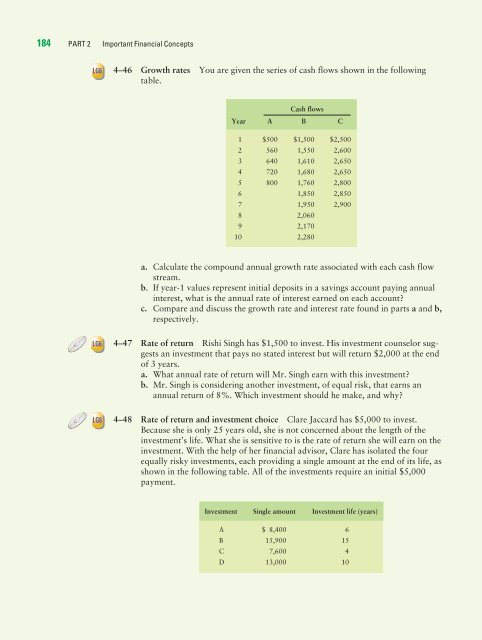Read the Chapter 4 E-Book
Read the Chapter 4 E-Book
Read the Chapter 4 E-Book
Create successful ePaper yourself
Turn your PDF publications into a flip-book with our unique Google optimized e-Paper software.
184 PART 2 Important Financial Concepts<br />
LG6<br />
LG6<br />
LG6<br />
4–46 Growth rates You are given <strong>the</strong> series of cash flows shown in <strong>the</strong> following<br />
table.<br />
Year A<br />
Cash flows<br />
B C<br />
1 $500 $1,500 $2,500<br />
2 560 1,550 2,600<br />
3 640 1,610 2,650<br />
4 720 1,680 2,650<br />
5 800 1,760 2,800<br />
6 1,850 2,850<br />
7 1,950 2,900<br />
8 2,060<br />
9 2,170<br />
10 2,280<br />
a. Calculate <strong>the</strong> compound annual growth rate associated with each cash flow<br />
stream.<br />
b. If year-1 values represent initial deposits in a savings account paying annual<br />
interest, what is <strong>the</strong> annual rate of interest earned on each account?<br />
c. Compare and discuss <strong>the</strong> growth rate and interest rate found in parts a and b,<br />
respectively.<br />
4–47 Rate of return Rishi Singh has $1,500 to invest. His investment counselor suggests<br />
an investment that pays no stated interest but will return $2,000 at <strong>the</strong> end<br />
of 3 years.<br />
a. What annual rate of return will Mr. Singh earn with this investment?<br />
b. Mr. Singh is considering ano<strong>the</strong>r investment, of equal risk, that earns an<br />
annual return of 8%. Which investment should he make, and why?<br />
4–48 Rate of return and investment choice Clare Jaccard has $5,000 to invest.<br />
Because she is only 25 years old, she is not concerned about <strong>the</strong> length of <strong>the</strong><br />
investment’s life. What she is sensitive to is <strong>the</strong> rate of return she will earn on <strong>the</strong><br />
investment. With <strong>the</strong> help of her financial advisor, Clare has isolated <strong>the</strong> four<br />
equally risky investments, each providing a single amount at <strong>the</strong> end of its life, as<br />
shown in <strong>the</strong> following table. All of <strong>the</strong> investments require an initial $5,000<br />
payment.<br />
Investment Single amount Investment life (years)<br />
A $ 8,400 6<br />
B 15,900 15<br />
C 7,600 4<br />
D 13,000 10

















